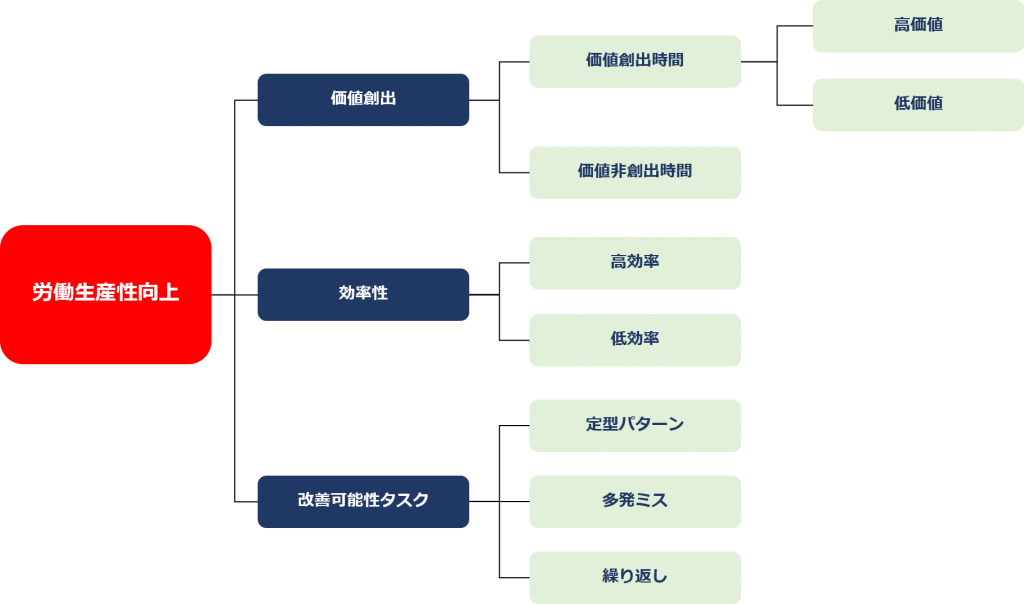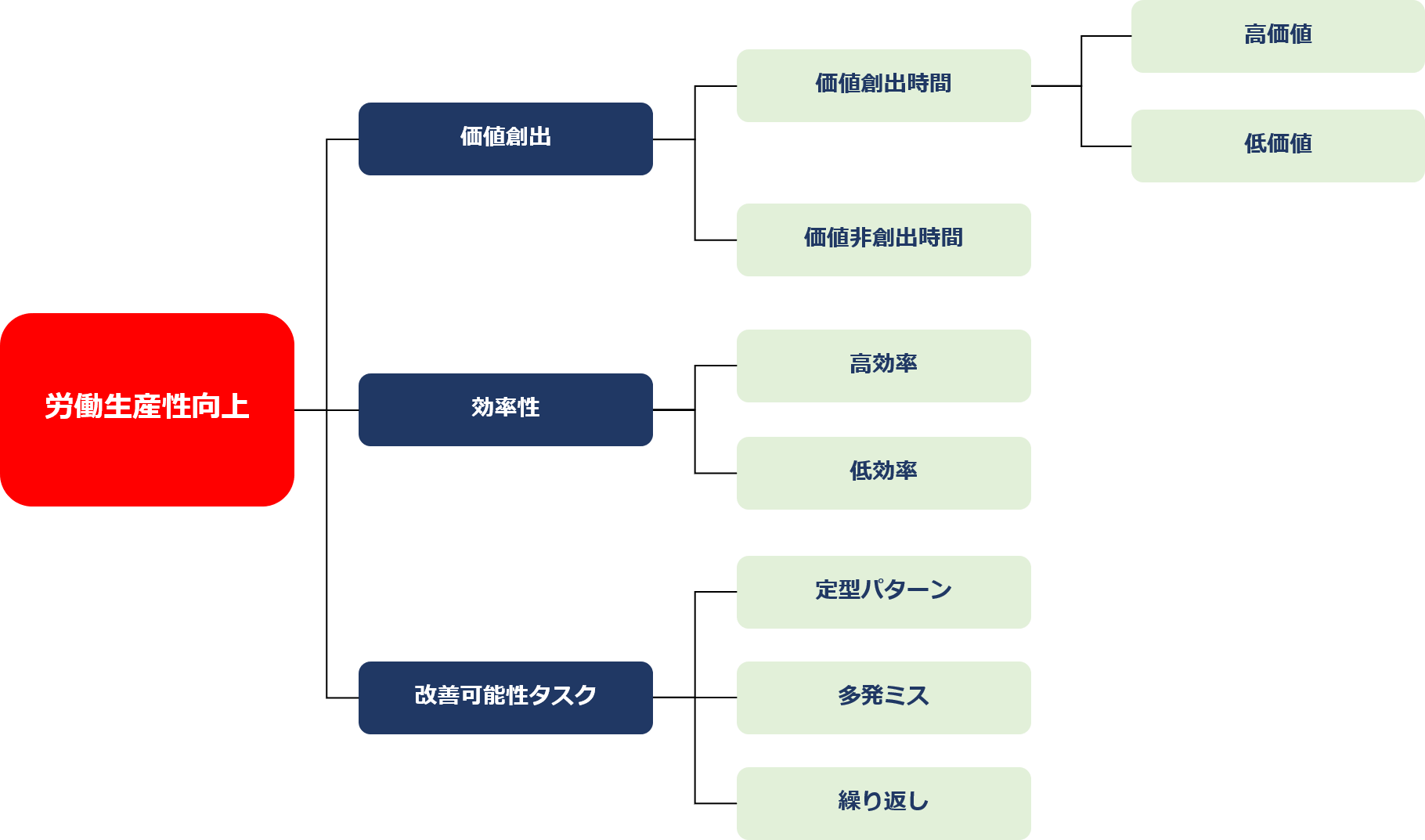Task Mining – Three Analytical Perspectives for Improving Labor Productivity.
English follows Japanese.Before proofread.
PC操作ログに基づき、ユーザー一人ひとりのPC上で遂行されたタスクを可視化するのが「タスクマイニング」です。
当記事では、タスクマイニングの基本的な分析アプローチとなる3つの分析視点を解説します。
まず、タスクマイニングを行う目的を明確にしておきましょう。それはズバリ、「労働生産性向上」です。生産性とは一般に
「産出(OUTPUT)」/投入量(INPUT)」
のことです。タスクマイニングにおける「労働生産性」は以下の式で表せます。
労働生産性=価値創出量/投入労働量
ここで、労働投入量は、一日当たりであれば一般的には8時間でしょうし、週当たり40時間、月当たり160時間が標準となります。(週休二日制の場合)。
端的に言えば、労働生産性向上とは、働いた時間で生み出す価値をより増やすことです。ポイントは、より長く働くことで価値を増やすのでなく、同じ時間で生み出す価値を増やすことを目指す点にあります。
さて、タスクマイニングでは、個々のPCにインストールされたセンサーを通じてPC操作内容を詳細に記録・蓄積できることから、労働生産性向上のために取り組むべき改善施策を検討するための分析を行うことができます。
この労働生産性の向上を目的とした分析には以下の3つの分析視点があります。
1 価値創出
2 効率性
3 改善可能性タスク
それぞれについて概説します。
1 価値創出
タスクマイニング分析の第一の視点は、業務時間のうち価値創出活動にどれだけ従事できているかです。
労働生産性の式でおわかりのように、労働とは価値を生み出すことです。「価値」は、わかりやすく言えば、売上に貢献するものです。工場労働の場合は、まさに「製品」が価値です。
オフィスでの各種事務の場合は、工場業務ほど明確ではありませんが、営業担当であれば、提案書や見積書作成は、売上をつくるために重要な価値創出活動です。どんな部署、業務であれ、なんらか価値を創出している業務時間のことは「価値創出時間」と呼びます。
一方、業務時間にYouTubeの動画を見たり、ただぼーっとしているだけの時間は価値を生み出していません。「価値非創出時間」となります。(なお、昼食、休憩時間は業務時間ではありませんので、そもそも分析対象ではありません)
労働生産性向上のためには、価値創出活動をできるだけ増やすことです。ただし、1日なら8時間という単位時間は増やさない前提です。したがって、8時間に占める価値非創出活動、要するに、いかになまけ時間・さぼり時間を減らすか、ということに取り組む必要があります。
したがって、まずは、タスクマイニングでは、業務時間を価値創出の視点で「価値創出時間」と「価値非創出時間」に仕分けしていきます。
なお、価値創出活動も2つに分けることができます。「高価値」と「低価値」です。高価値は、営業担当で言えば、前述した提案書や見積書作成です。低価値な業務としては、経費精算や客先移動です。
低価値業務もできるだけ減らすことを目指したいところ。例えば、経費精算は、専用アプリなどで手順をできるだけ簡素化したり、RPAで自動化したり、またWeb会議によって移動時間をなくす、といった施策が打てます。
2 効率性
同じ価値を生み出すにしても、仕事が早い人、遅い人で時間のかかり方が違いますね。したがって、価値創出、非創出を仕分けしたら、次は価値を生み出す時間の短縮を目指す、すなわち効率性を追求します。
タスクマイニングにおいて効率性の分析を行う場合には、基準値の設定が必要となります。要するに、同じ仕事をするにしても、「高効率」、つまり仕事が早いのか、「低効率」、すなわち仕事が遅いのかは、なにか評価基準を設定しておかなければ判断できません。
この基準値は一般には、部署別や職務別での平均処理時間などを用いますが、ヒアリングによる業務分析と異なり、タスクマイニングでは、実際の「PC操作時間」というファクトに基づく分析が可能です。
3 改善可能性タスク
タスクマイニングの3つめの分析視点は、改善可能性タスクを発見することになります。前2項目(価値創出、効率性)では、業務処理時間に焦点を当てますが、改善可能性タスクは、業務の流れに着目します。
そして、なんらか改善できるのではないかと考えれられるタスクを抽出します。主な抽出対象は、「定型パターン」、「多発ミス」、「繰り返し」です。
「定型パターン」は、いくつかのステップが順番に行われているものです。休暇申請や出張精算などが典型的な定型パターンです。こうした手順はしばしば業務システム化されているのでプロセスマイニングでも分析が可能ですが、業務システム化されていなくとも、タスクマイニングでは発見可能です。「多発ミス」や「繰り返し」は、アプリやファイルの操作の流れの中で異常値的に発見されるもので、多くは「コピー&ペースト」が大量に含まれています。
これら改善可能性タスクに対する具体的な改善施策はケースバイケースではありますが、RPAによる自動化が最有力施策と言えるでしょう。
以上、タスクマイニングでは、「価値創出」、「効率性」、「改善可能背タスク」の3つの視点で分析を進めていくことをご説明しました。タスクマイニングでは他に、コンプライアンスに関わる違反プロセスの発見といったことも可能ですが、労働生産性向上にはさほど関係しないため、別の機会にご説明したいと思います。

Task Mining – Three Analytical Perspectives for Improving Labor Productivity.
Based on PC operation logs, “task mining” visualizes the tasks performed on each user’s PC.
In this article, let me explain the three analytical perspectives for task mining.
First, let’s be clear about the purpose of doing task mining. That is improving labor productivity.
Productivity is generally defined as
Output/Input
Then, the “labor productivity” in task mining can be expressed by the following formula;
Labor productivity = amount of value created/labor time(cost) spent
Here, labor input, if per day, would generally be 8 hours, and 40 hours per week and 160 hours per month would be the norm. (If you are on a two-days off per week).
In a nutshell, increased labor productivity is about creating more value with the hours worked. The point is not to increase value by working longer, but to increase the value you create in the same amount of time(cost).
Now, with task mining, PC operations can be recorded and accumulated in detail through sensors installed on individual PCs, allowing analysis to be performed in order to consider improvement measures to be taken to improve labor productivity.
This analysis aimed at improving labor productivity includes the following three analytical perspectives
1 Created Value
2 Efficiency
3 Task to be improved
I will outline one by one.
1 Created Value
The first perspective of a task mining analysis is how much of your business time is spent engaged in value-creating activities.
As you can see from the labor productivity formula, labor is about creating value. Value, to put it plainly, is what contributes directly or indirectly to sales. In the case of factory labor, it is exactly the “product” as a result of creating the value.
In the case of various types of office work, it is not as clear as factory work, but if you are in charge of sales, preparing proposals and quotations are important value creation activities to create sales. The time that any department or business is creating value in some way is called “value creation time”.
On the other hand, time spent watching YouTube videos or just zoning out during work hours is not creating value. This is “non-value creation time. (Note that lunch and break times are not included in the analysis in the first place, as they are not business hours.)
The way to improve labor productivity is to increase value-creating activities as much as possible. However, it is assumed that the unit time of 8 hours will not be increased for a day. Therefore, it is necessary to work on how to reduce the amount of non-value-creating activities, in other words, the amount of slacking and idleness in the eight hours.
Therefore, first of all, task mining classifies business time into “value creation time” and “non-value creation time” from the perspective of value creation.
Value creation activities can also be divided into two categories. They are “high value” and “low value. High value is the aforementioned proposal and quotation writing, if you’re a salesperson. Low-value tasks include such as expense reimbursement and customer travel.
We should aim to reduce low-value operations as much as possible. For example, for expense reimbursement, you can simplify the procedure with a dedicated application, automate it with RPA, and eliminate travel time with web conferencing.
2 Efficiency
Even though they create the same value, it takes different amounts of time depending on the people who work faster or those who work slower. Therefore, after sorting out value creation and non-creation, the next step is to seek efficiency, in other words, to reduce the time to create value keeping the same value created.
When analyzing efficiency in task mining, it is necessary to set a reference value. In short, even if we do the same work, we can’t judge whether the work is highly efficient without setting some kind of evaluation criteria.
In general, this standard value is based on the average processing time by department or job category. The good thing is, unlike interview-based business analysis, task mining can be analyzed based on the actual “PC operation time”.
3 Task to be improved
The third analytical perspective of task mining will be the discovery of improvement potential tasks. While the previous two items (created value and efficiency) focus on business processing time, the improvement potential task focuses on the flow of work.
Firstly, we find and extract the tasks that we think could be improved somehow. The main targets for extraction are “routine patterns”, “multiple mistakes” and “repetition”.
A “routine pattern” is one in which several steps are taken in sequence. Day-off requests and business travel settlements are typical routine patterns. These procedures are often systematized into business systems, so they can be analyzed by process mining, but even if they are not systematized into business systems, they can be discovered by task mining. The “multiple mistakes” or “repetitions” are outliers found in the flow of app and file operations, many of which involve a large amount of “copy and paste”.
Although specific improvement measures for these potential improvement tasks may occur on a case-by-case basis, automation with RPA is the most likely solution.
Above, we have explained that in task mining, the analysis is carried out from the three perspectives of “created value,” “efficiency,” and “task to be improved”.
Task mining can also do other things, such as finding non-compliance processes that are related to compliance, but this is less relevant to improving labor productivity and will be discussed at another time.

